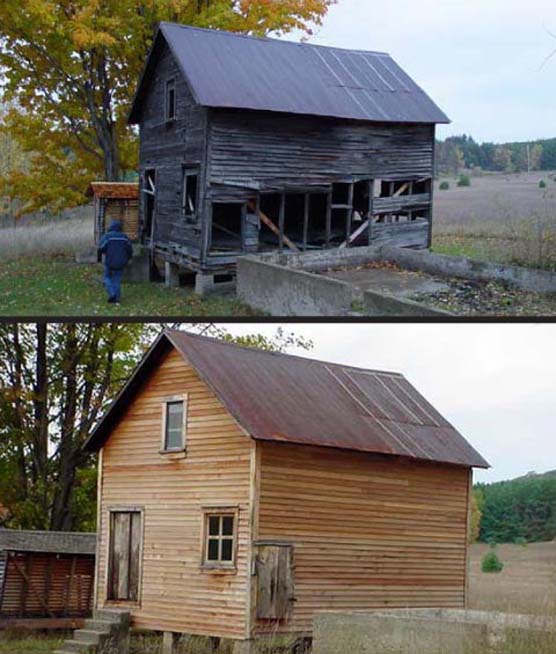|

NPS
Contact: Lee Jameson, 231-326-5134 Although funding for historic and cultural resource projects in National Parks is getting harder to come by, Lakeshore staff at Sleeping Bear Dunes has found ways to stretch those dollars by working closely with partner organizations to leverage available funds with the energy and enthusiasm of volunteers. Together, they are successfully overcoming funding shortfalls and are saving the area’s cultural history brick by brick, field by field. “We are fortunate to have a skilled preservation crew and partnerships with organizations who share our same vision of preserving the cultural resources of the Lakeshore,” said Dusty Shultz, Superintendent. According to the Lakeshore’s annual report, volunteers contributed more than 28,000 hours at the Lakeshore this year. “With their dedication and help, we have been able to provide needed visitor services and continue preservation efforts to save historic structures in Port Oneida and other areas of the Lakeshore,” said Shultz. The Lakeshore staff has been hard at work restoring cultural resources. The Buildings and Utilities crew rehabilitated the Esch house south of Empire, and it looks great! The work at Esch included replacing deteriorated sills, repairing the stone foundation, installing utilities and windows, and a fresh coat of paint. This work will prepare the house for adaptive use as park housing. In Port Oneida, this skilled group of craftsmen transformed the appearance of the Kelderhouse farmhouse by replacing siding and the roof. They also re-sided the Dechow and Peter Burfiend granaries, roofed the Peter Burfiend farmhouse, and upgraded utilities in the adaptively used Dechow farmhouse. Elsewhere, the Eitzen farmhouse on Townline Road was roofed, and the North Manitou Island U.S. Life-Saving Service Crew Ready Room window frames were repaired. Numerous smaller preventive maintenance projects were also completed to stabilize historic structures. A significant new project accomplished by the Lakeshore’s Roads and Trails crew cleared historic farm fields in the Port Oneida Rural Historic District cultural landscape. The crew worked through the heat of summer to cut and pull encroaching vegetation from the Peter Burfiend, Kelderhouse, and Lawr farmsteads. Highly invasive, non-native black locust trees were cut and used as posts to restore historic fence rows in the newly cleared fields, improving their appearance dramatically. In another unique project at Glen Haven, Lakeshore volunteers and maintenance staff began the rehabilitation of the Fish Tug Aloha. New decking, framing, and sheet metal were installed and additional preservation work is planned to occur next season. In July, the park hosted the 10th annual Michigan Barn Preservation Network workshop at the Ole Olsen barn in Port Oneida. Working with park staff, participants helped to repair the failing stone masonry foundation and bay floors, and replace deteriorated center posts. This workshop series preserves historic structures while also training the public in traditional building skills. A similar partnership continued with the Leelanau Conservation District, Michigan State University Horticultural Station, and the Leelanau Master Gardener Program in presenting a tree pruning workshop for park staff and the public. This year’s workshop took place at the Miller orchard in Port Oneida in May, with 55 people in attendance. Park partners have also been busy. Over the summer “Preserve Historic Sleeping Bear” installed siding and stabilized the Martin Basch granary, repaired boardwalks and windows at the Boekeloo cabin and made improvements to the Olsen farmhouse, their adaptive use home. Volunteers from the Glen Arbor Art Association continued work in the Thoreson farmhouse for a new sill between the kitchen and back room. The Manitou Island Memorial Society volunteers completed restoration of the South Manitou Island (SMI) schoolhouse interior and repaired fencing around SMI cemeteries. The Huron Valley Sierra Club has an 18 year history of volunteer work on North Manitou Island. This year they cleared juniper from gravestones in the historic island cemetery prior to a burial. Other park volunteers repaired the roof on the Bufka smokehouse, finished earlier work on the Lawr chicken coop, restored the Johnson privy in the SMI village, helped park staff reset the Bufka privy on its foundation and repaired the Peter Burfiend granary in Port Oneida. Thanks to the “Friends of Sleeping Bear Dunes” and other partnership groups, the popular Annual Port Oneida Fair special event in August continues to raise awareness of one of the most complete early 20th century agricultural landscapes. Visitors get a taste of early settlement life and agricultural history and are often inspired to get involved in saving the district. The “Friends of Sleeping Bear Dunes,” a non-profit partner, has secured a Michigan Humanities Council grant and will host the fair in 2007. “Partner organizations and volunteers working along with National Park Service staff are vital to our success in saving the cultural resources at the Lakeshore,” said Lee Jameson, Facility Manager. Anyone interested in Port Oneida or other historic sites within the Lakeshore may contact the Lakeshore staff at (231) 326-5134. |
Last updated: April 10, 2015
